Aloha Kākou, Keili here.
Sorry for the late post. I am writing to you in the late night from Newport, California. Last minute, I decided to join Chris and Kalani here, with ʻAʻĀ where they have been working on her for the last week. Iʻd been having a rough week at work and needed to just get out of my day-to-day / get back in my element. Although I am quite sleep deprived, sunburnt, and dirty (only 3 days in) - I can say that I am feeling much more fulfilled.
That being said - allow me to unpack some of the blessings and lessons that my crew and I have had thus far.
My trip in and of itself was a kind gift from my aunty Debi, uncle Jim, and cousin Kyle. I arrived to a reunion with my cousin, grandma, and grandpa at my aunt and uncles house. We even got to enjoy a homemade meal with fresh yellowtail that my dad had caught a few weeks prior (spoiled).
Chris and Kalani came to pick me up the next morning in a car stuffed with every part imaginable to put ʻAʻā together and reeking of resin. They managed to hollow out a spot for each of us to sit, roll down the windows, and off we rambled towards the Newport canoe club where Chris and Kalani had made new friends. We met up with Uncle Bill, a joyful and accomplished waterman with an enthusiasm for our ambitious voyage. He towed us 3 miles under a bridge to a calm beach where we planned to finish her lashings. After the first hour, we came to the realization that the tide changes were not cooperating (ʻAʻĀ kept threatening to float away) and moved to a temporary dock. At only 40$ a day, we decided this temporary slip was a handsome fit for the job (not to mention she fit perfectly, so we could do lashings and stay somewhat dry).
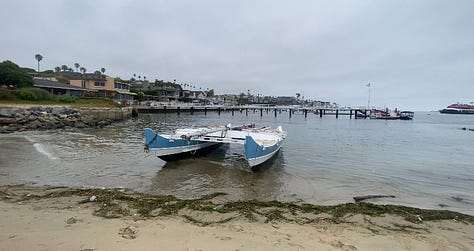
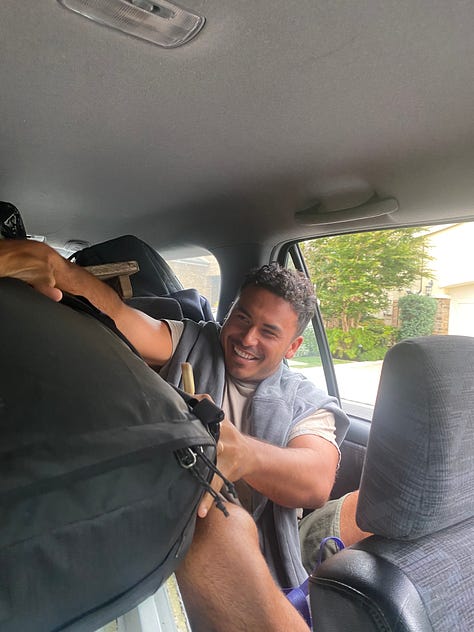
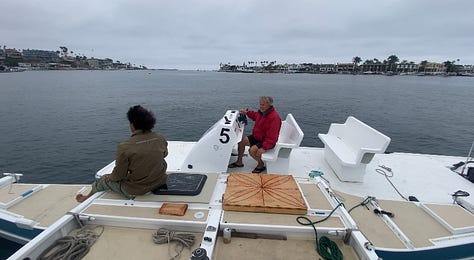
Day one: Kalani, Chris and I finished 10 lashings using a huki stick. Our huki stick came with ʻAĀ, they were used traditionally by Polynesians to do lashings. This method is an ingenious ancient skill that uses friction, strength, and pressure to keep our boat together. The benefits of lashings are: 1) we have flexibility (like a tree needs to bend in the wind), we need to move with the seas. 2) they help in the case of an emergency - lets say, if a lashing were to break, at least we could lash it together somewhat easier than someone who was using a metal screw to hold the boat together. The sailor depending on metal needs a locksmith tor welder to create a new (probably custom) piece to fit their vessel, whereas we just need a stick and strong rope.
Once we finished the lashings, we tidied up and got ready to put in our 4 trampolines
Day two: Andrew spent the previous day sewing our new trampolines and adding metal rivets. So, we spent day 2 figuring out how best to lash our fancy new trampolines into the small holes that seemed too few & far between. Together, we figured out a few successful methods. Luckily, we were in good company, having both Kalani (an experienced canoe rigger) and a new friend, Uncle Kevin (who lashed boats professionally for many years).
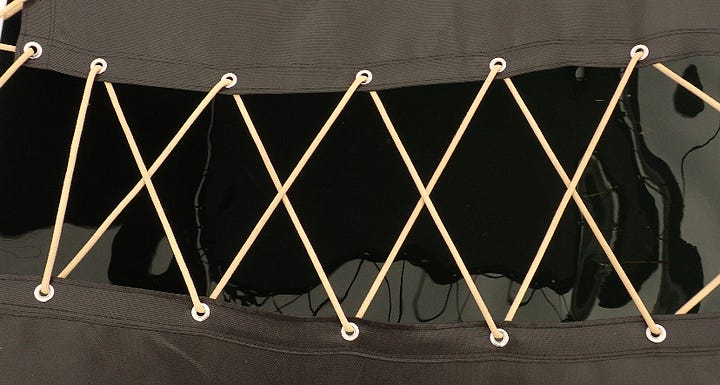
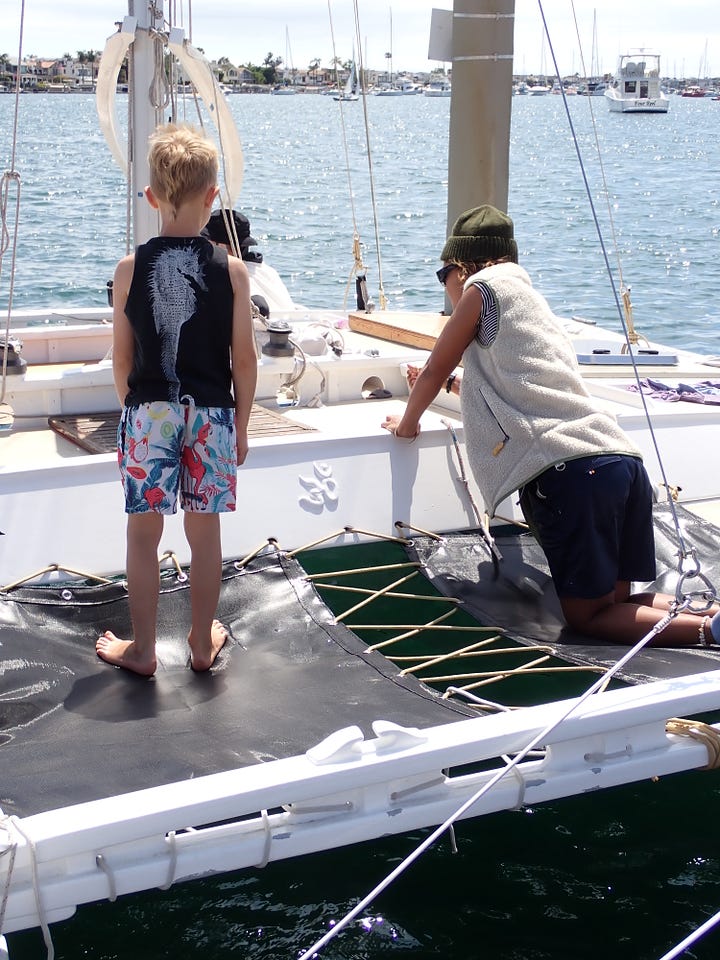
Day 3: We put up the the mast! Though to an outsider this may seem a small task to take up about half the day - it was a huge feat for us. Despite being the heaviest item on deck, the task required less strength (although, we did put a team of 6 to work) and more theorizing points of balance, and organizing stays and lines to be sure all was in the right place. Despite hours of wrapping, straitening, following lines, and communicating with one another on where each part was supposed to go - we still found ways to improve next time. But - the mast did go up - WOOHOO!
Last time we raised the mast, we used a tall ladder to hoist up the mast on one side of the canoe, connected the side stays so that it would not tip to either side, and pulled lines on the other side to hoist the mast up. This time, we tried a new tactic using similar logic. Uncle Kevin climbed to the higher level of our dock with a line that was tied to the to of the mast. On the other side, the mast was tipped horizontal to ʻAʻĀ across the center of the deck, and placed gently out towards the harbor where our new friend, Uncle Mark, held it in the water with a kayak (shoutout uncle Mark for braving the cold and murky waters). Kalani, Andrew, and I steadied the center of the mast, ensuring that it aligned well and clicked into place at the center of the boat. As Uncle Kevin pulled, Tristan and a few other new found allies from the Newport paddling club held the other stays and tied them tightly into place as the mast became upright. It was a very stressful couple of hours, and Chris orchestrated it all. If anything goes wrong while bringing up the mast you can easily wreck your vessel completely.
For those of you who do not understand how a mast stays in place if it is not a part of the boat - don’t worry - I didn’t get it at first either. Basically, the mast is held snuggly in a specially designed groove that sits just in the center of the boat. What keeps the huge (100-180LB) thing from tipping over and crushing the boat entirely are a number of stainless steal wires, called stays or shrouds, that extend from the top of the mast out to each corner and sides of the deck. We tighten the shrouds to a series of heavy duty shackles that will work in unison with one another to compensate with any rocking or change in weight distribution.
Day 4: We finish putting in the trampolines - yay! And, thanks to Kalani & Andrews skill and artistry, they look secure AND aesthetic. Then, with giddy excitement, we get to put in our shiny new engine. Together, we try and explain her unique features (like how to lock the throttle in place), and best practices (like getting an oil check after the first 15 hours of use). We try not to let our excitement keep us from accomplishing the other tasks that are begging to be completed. Kalani leaves the next day, which drives us hard into concentration mode in order to get him out sailing before he departs. We promptly and diligently place in a temporary centerboard of recycled teak wood, hoist up the halliard (proudly waiving the HI flag), make adjustments to the trampolines, do some ding repair, connect the sheets and sails and clear the deck of accessible amounts of line, tape, knives, and other tools.
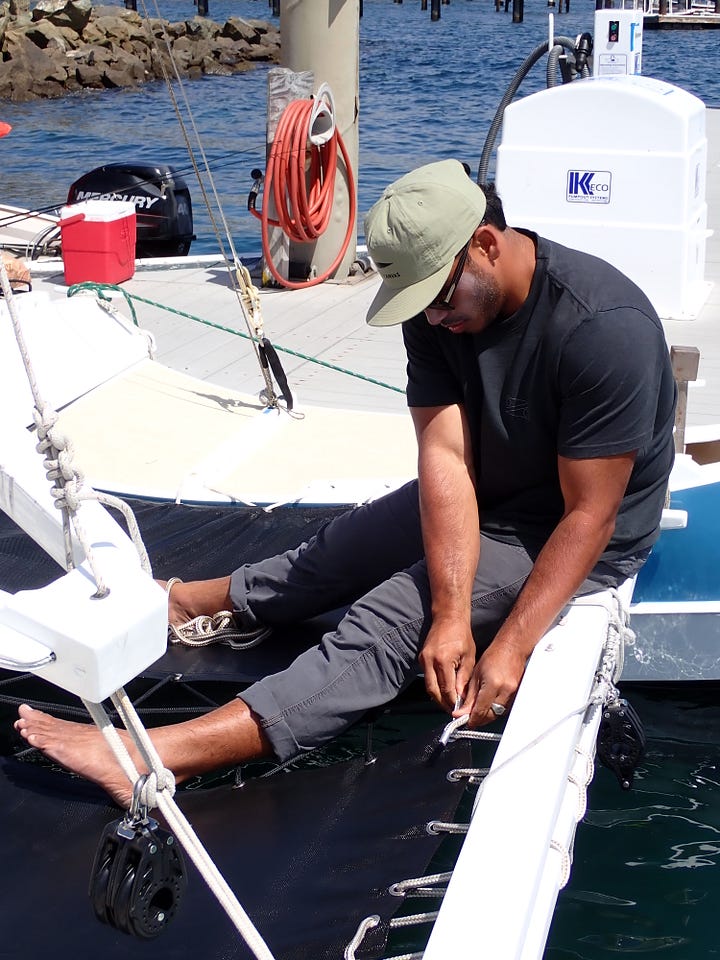

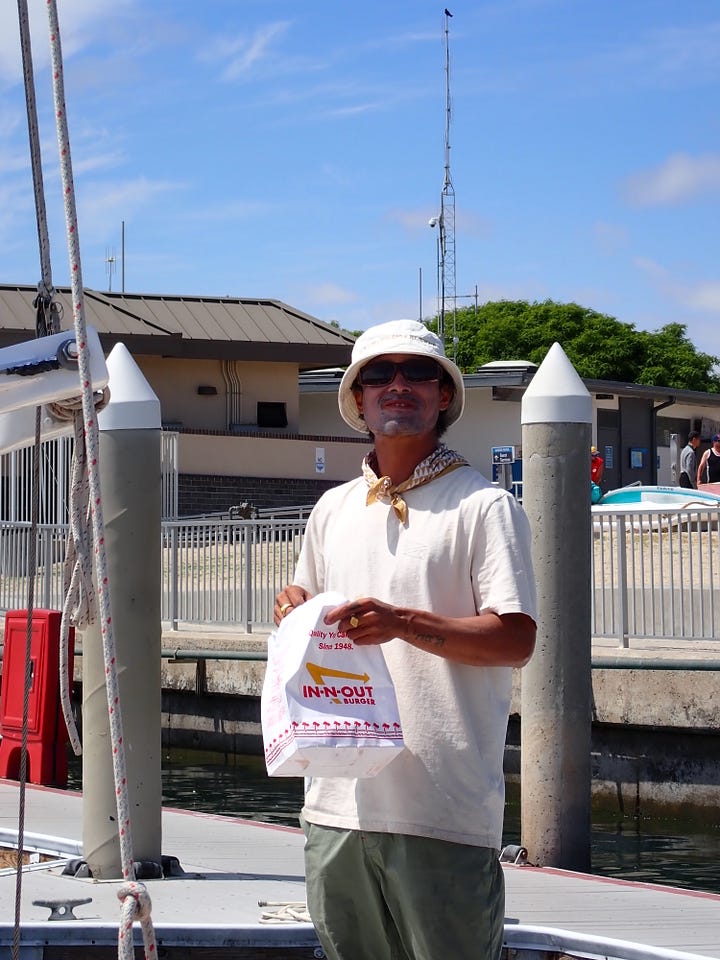
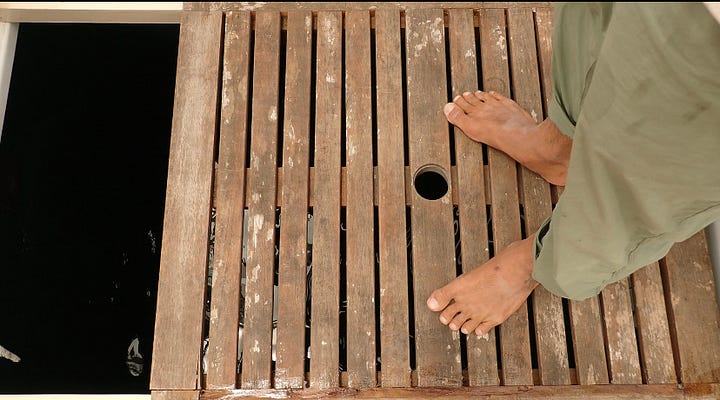
Somehow, it seems we acquired a crew of dedicated Menehune out in the middle of Newport. Quicker than seemed possible merely days earlier - we had ʻAʻĀ in the most beautiful shape sheʻd ever been! I try not to be excessive, but take any opportunity to express gratitude towards our kind new friends that seem the stark opposite of much of the local community we had come across in the area. Unapologetically kind, charitable, trusting, and encouraging - I found myself gaining confidence in our passage and my own capability to learn and work through this new ʻOhana.
Even though our first sail couldn’t have been more than a mile, it was one of the most rewarding sails we had had! Our three Menehune crew joined by our extended family - we exchanged smiles and recalled our successes and failures in getting to this point.
Day 5: With tired eyes, we drag our feet to drop off Kalani, at LAX airport. He has a wife, job, and baby goats to get back to - but selfishly we want him and his craftsmanship, waterman skills, and positive energy to stay with us and ʻAʻĀ a little longer. With no wind, we decide to enjoy a little play and all run eagerly into the glassy surf, gliding on our bellies across the freezing waters. After a goodbye with promises of studying and checking off many to-doʻs from our lists while we are all apart, Chris, Tristan, and I return to ʻAʻĀ for a peaceful sunset sail. Watching tell tales intently, and observing the natural world, we are content to sail slowly on a beam reach. We mimic the seals sprawled out along the Newport bell, soaking up the sun on our hulls and looking out for any missed cracks, creaks, or other overlooked items.
Day 6: Chris, Tristan and I enjoy a slow morning for once at my aunt Debi & uncle Jimʻs with my family. It is pretty amazing how much you enjoy simple things like familiar loving company, pizza, a cold beer in a jacuzzi after a few days spent working in the sun! Again, not much wind in the AM, so we decide to grab boards from the Ola Canvas shop and jump in the glassy waters (with wetsuits this time, thankfully).
Attempting to take as much off Chrisʻs shoulders as I can while I am there, we zip around and check a few more items off the ever-long check list. Unfortunately, we are still unable to find a temporary slip for ʻAʻĀ to stay until July… Hopefully we can find one that wonʻt completely break the bank, the only one we are able to find is a steep $1,300! The alternative is to sail back down south to a slip that is more affordable. Unfortunately, this would be far from our newfound ʻOhana and Ola Canvas shop where Chris and Andrew have been completing a lot of work for Ethnomads. Not to mention, it would add some distance upwind for our voyage when we set off for Hawaiʻi.
Now, I finish writing my recollection to you sleepily, excitingly, and with quite a bit of FOMO from the airplane headed back to ʻOahu. I hope you enjoyed my playback as much as I did - thanks for giving me a chance to relive it, it is something I am sure never to forget.
This trip served as a great reminder of what is truly important to me, how to embody who I wish to become, and that being kind and showing aloha is really what being alive is all about.
-Keili
PS: sorry for the long email thread, thanks for reading this far!!
Again, a huge mahalo to all those who helped ʻAʻĀ get in the water safely, have supported Chris and I along the way, and encouraged us through the sharing of knowledge and experience. As always, this is dedicated to my mother who always encouraged me to follow my dreams and do what I think is right.









